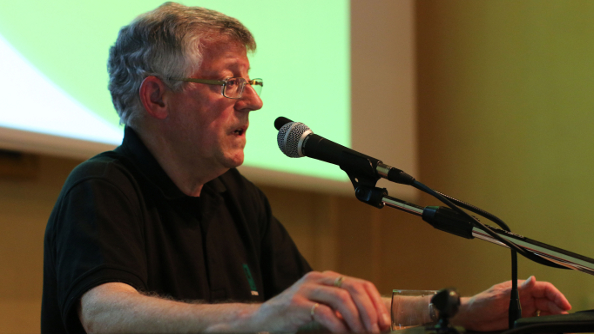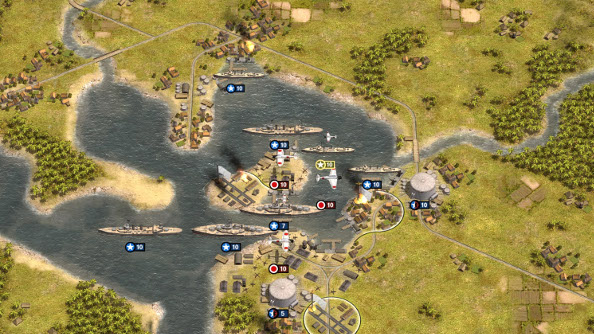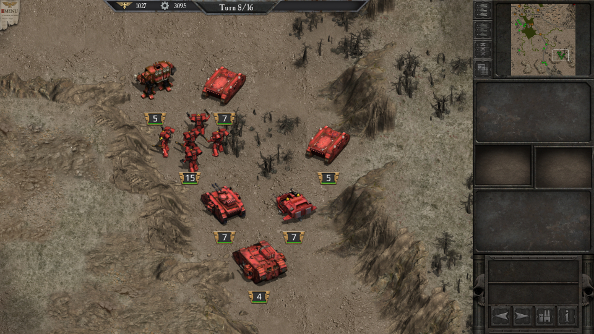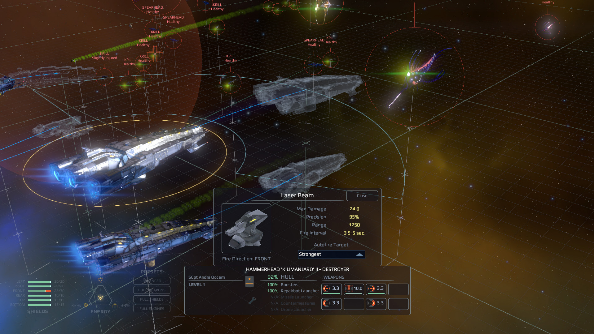“Anyone saying they have a five year plan is talking out of the back of his neck,” JD McNeil, Slitherine’s CEO, told me last year. It’s a tumultuous industry, was his point, and a fluid one, threatening to leave long-term plans in disarray. Speaking with him again, last week, it looks like he’s right.
Within the space of one year, not five, Slitherine’s direction has changed dramatically. There’s a renewed focus on PC, an in-house engine taking the place of Unity and a big internal change that means Slitherine is a publisher only, now, leaving wargame development to its internal studios and partners.
Last year, McNeil was excited about multiplatform games. With Unity, Slitherine’s engine of choice at the time, it was easier than ever before to port games like Panzer Corps over to iOS and Android, and the company was busy working on ways to make the complex UIs that wargames are known for more accessible.

Now, those changes to the UI are being called “sacrifices” and the iOS and Android market is not longer as attractive as it was. Slitherine is mainly a PC publisher, and this year it feels like this is being reaffirmed.
“It’s absolutely correct that we’ve altered our focus,” McNeil told me. “The plan was, at the build stage, that we’d construct the games for multiplatform. That meant making sacrifices to the UI, in particular.”
These sacrifices must have seemed worth it, at first. It was new territory for Slitherine, sure, but these games were also refreshingly different when compared to the crop of 15 minute time wasters and shameless clones that fill the App Store and Google Play.
Unfortunately the “tide turned,” as McNeil put it. Initial successes made way for the difficulties of getting games recognised on these saturated mobile platforms. There was a lot of pressure, competing with the startling number of new releases that Android and iOS get every day.
“No idea how an indie developer does it,” he said.

So there was a lot less talk of mobile gaming at this year’s Home of Wargaming developer conference. A lot less talk of Unity, too. Instead of relying on that engine, Slitherine’s making a risky move, developing its own engine specifically for its developers. An engine for wargames, built by wargamers. It’s called Archon.
“No matter how good Unity is, and it is very good, it still has it challenges with the products we make,” said McNeil. “In a couple of games, we struggled quite badly to make Unity work on this particular kind of gameplay.”
While Slitherine’s developers won’t be pressured into using Archon, and we might still end up seeing a few Unity games, McNeil emphasises that Archon is being designed with their developers in mind. And having an internally developed engine means that Slitherine can provide direct support to its studios should anything go wrong, and they can drop features in their at the request of these developers. A new play by email system is also in the works, as it continues to be a popular multiplayer method in wargaming.
One of the problems with developing a brand new engine is that it takes focus away from game development, but that’s not going to be an issue for Slitherine. Development of Slitherine’s games, like Close Combat and Panzer Corps, will be handled by three internal studios, leaving Slitherine to play a support role, working exclusively as a publisher.

I wondered if this has created new risks for Slitherine, though. Surely one of the appealing things about Slitherine, for developers looking for a publisher, is that they know wargames inside out; they’ve been developing them for years. Will the switch to exclusively publishing leave them out of touch?
“Not a chance,” responded McNeil. “We’re so deeply embedded with these guys. We’re developing 50 games at the moment, and we are deeply involved. The role that we play with the developers is not that we market their game and release it. We are with them right along the route. We are with them right from the start, even from the concept stage in some cases.”
Amid all of these changes, Slitherine is also trying to expand its audience. It’s got a clear idea who its demographic is: affluent, well-educated 30-60 year olds, almost exclusively male.
“This audience is rich and available,” I’m told. And McNeil seems to be content with that demographic. He just wants more of them. These are wargamers rather than gamers, and that’s why you’re not going to spot Slitherine at E3, but you might see a stand at a board game convention.
Slitherine wants to grow, it wants more people playing these games, but it’s only trying to court people who are already wargamers. It’s not a surprise: wargaming is all very insular. McNeil agrees and says it’s Slitherine’s job to burst that bubble, but it sometimes seems like the publisher embraces that insular nature.

Is Slitherine uncomfortable with change? McNeil says it isn’t, and certainly there have been a lot of changes in the last year, but there’s a sense of hesitancy, or at least plenty of caution, especially when faced with things like Let’s Plays and Twitch streams. Comfortable or uncomfortable, it is still experimenting with new ways to reach potential players.
A Twitch Q&A last year was the first time Slitherine did anything like that, but now it’s streaming more regularly, and even hosted a 10 hour stream for the anniversary of the Battle of Waterloo. It’s dabbling in Early Access, too, though that’s unlikely to become common, and, more surprising, it’s even had a Humble Bundle up, as well as sales on the Humble Store and Steam.
Slitherine doesn’t normally do big discounts, so seeing their games available for however much you want to spend was a bit of a shock. This hasn’t changed how McNeil views the sale-mad nature of the modern industry, though. It’s not sustainable, he reckons.
“Take the so-called indie developers, where this great splurge of activity’s happened. They’ve released their games, it’s taken three, four, five guys a year or two years of their life, living on bread and butter, and they release a game and they sell it at 5 bucks a go? It’s suicide. Absolute suicide, and we won’t allow our developers to get caught in that stupidity.”
I can’t help but wonder where Slitherine will be in a year’s time, after its new engine has seen some use, once it’s settled into its role as a publisher, rather than the hybrid it once was. There are the unusual partnerships as well, like its team-up with BAE Systems, and it’ll be interesting to see where they lead. But the last year has proved that there’s no point in guessing.
